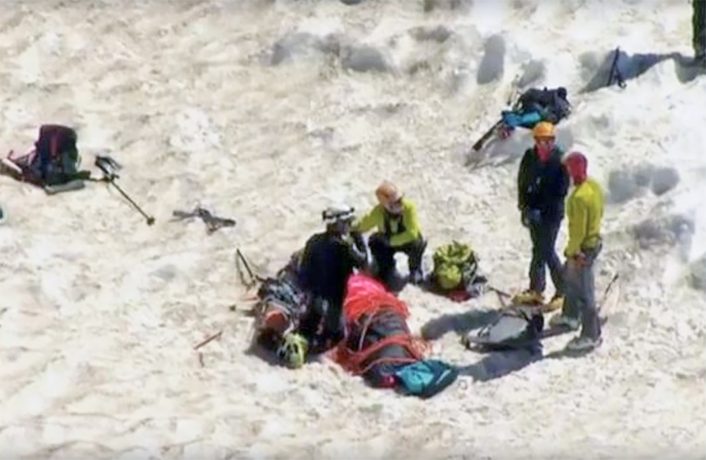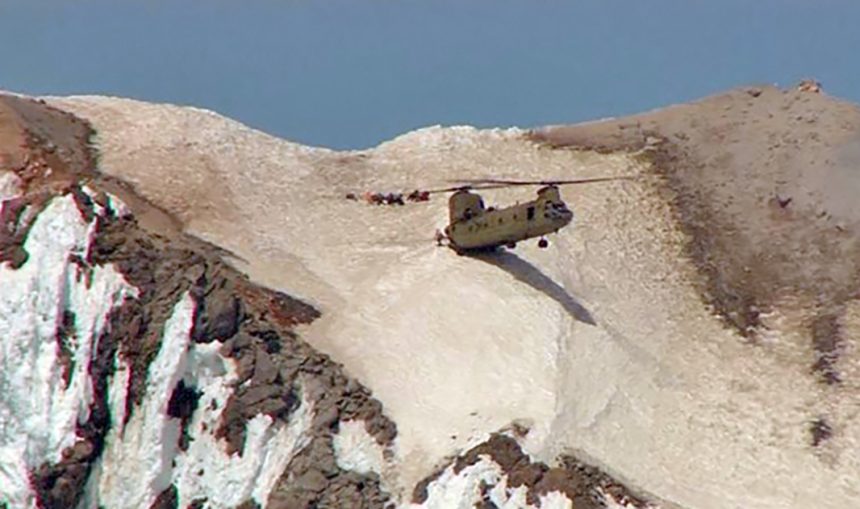U.S. National Guard Helicopter in Dramatic Mountain-Top Rescue
For the third time in four weeks a U.S. military aircraft has participated in the rescue of a civilian in life-threatening circumstances. This time it was in the United States and the incident was a direct rescue of a 27-year old male victim from a dangerous, high altitude location on Oregon’s 11,249-foot Mt. Hood.
Two helicopters including an Oregon Air National Guard CH-47 Chinook heavy lift helicopter responded to an emergency 911 phone call from the mountain at approximately 14:30 LT on Friday, July 13, 2018. According to reports, one of the aircraft that initially responded was a single main rotor UH-60 Blackhawk. Because of the altitude of the rescue, well above 10,000 feet in thinner air where rotary wing aircraft can have difficulty maintaining lift, the larger twin-rotor CH-47F Chinook was used for the rescue.
The CH-47F belonging to the 168th Aviation Regiment, based in Pendelton, Oregon, performed a so-called “Pinnacle Landing” or “Pinnacle Maneuver” (often seen in theaters like Iraq or Afghanistan) making the rescue possible.
In addition to the thin air at high altitude, dangers in alpine helicopter rescues include unpredictable mountain winds with powerful up and down drafts on steep terrain and unstable glaciers with common avalanche, crevasse and icefall risks. In the alpine region of the Pacific north west, high, glaciated mountains including Mt. Rainier in Washington state at 14,410 and Mt. Hood in nearby Oregon account for a disproportionate number of alpine fatalities because of their close proximity to large urban populations and their easy access for recreational use.

The dangers of helicopter rescues on Mt. Hood were underscored in a tragic May, 2002 attempted rescue of four injured climbers on Oregon’s Mount Hood, when an HH-60G Pave Hawk of the Air Force Reserve Command’s 304th Rescue Squadron crashed on live television, rolling down the mountain after losing lift in shifting mountain winds. During that 2002 incident, three people died and four others were critically injured after they fell into a crevasse on the mountain near Timberline Lodge. One member of the rescue team was also critically injured when the helicopter rolled over him as it tumbled down the mountainside after crashing.
This is already the second helicopter rescue from Mt. Hood in 2018. The first rescue took place on Tuesday, February 13, 2018. A climber fell approximately 1,000 feet into the Hogsback area on Mount Hood and did not survive. Rescuers guided down two others who were stranded and rescued a third by sled evacuation that Tuesday night. In that rescue, a UH-60 Blackhawk helicopter was used.
Lifelong mountain guide Brent Okita of Rainier Mountaineering Inc. (RMI) told us, “These are the only high mountains with glaciers in the world that have a freeway exit. Because of that, you get a lot of inexperienced people in a situation can deteriorate quickly.”
In a potentially tragic twist to this latest story, the man rescued reportedly climbed Mt. Hood to commit suicide but later reconsidered and then phoned 911 emergency responders. “The Clackamas County Sheriff notified us that [the climber] had gone to the summit of Mount Hood because he was going to end his life up there, and then he changed his mind,” Scott Lucas of the Oregon Office of Emergency Management told media on Friday.
The man was initially thought to be lower on the mountain following the 911 emergency call, but Army National Guard search and rescue crews located him closer to the summit of the mountain.
Top image: an Oregon Army National Guard CH-47 Chinook rescues a climber and recovers rescue team from Mt. Hood, Oregon on Friday, July 13, 2018. (Photo: CBS/via Associated Press)








